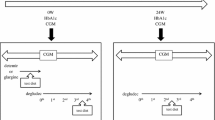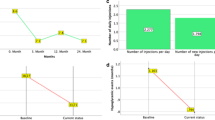Abstract
The purpose of this study was to assess the efficacy of insulin degludec compared with insulin glargine and to find a safer way of switching from insulin glargine to insulin degludec. By use of a crossover design we compared preprandial blood glucose levels for patients with type 1 diabetes when insulin glargine or insulin degludec was injected in combination with pre-meal rapid-acting insulin. Insulin degludec was given before dinner at the same dose as insulin glargine to patients receiving insulin glargine once per day. When insulin glargine was given twice per day, the dose of insulin degludec was reduced by 20 % of the total dose of insulin glargine. We could safely replace insulin glargine with insulin degludec by use of this procedure without occurrence of severe hypoglycemia. There was no difference in fasting plasma glucose levels between insulin glargine and insulin degludec, indicating the appropriateness of the insulin degludec dose. However, blood glucose levels before lunch were lower when insulin degludec was used. Furthermore, the frequency of mild hypoglycemia was slightly higher before lunch in the period of insulin degludec injections, although the difference was not statistically significant. Thus, in type 1 diabetes, insulin degludec more effectively reduces glucose levels before lunch than does insulin glargine, probably as a result of steady supply of basal insulin. The potential risk of hypoglycemia before lunch may be reduced by reducing the morning dose of bolus insulin. For patients prone to hypoglycemia, it may be prudent to start insulin degludec injections at a lower dose.


Similar content being viewed by others
References
Jonassen I, Havelund S, Ribel U, Hoeg-Jensen T, Steensgard DB, Johansen T, Haahr H, Nishimura E, Kurtzhals P. Insulin degludec is a new generation ultra-long acting basal insulin with a unique mechanism of protraction based on multi-hexamer formation. Diabetes. 2010;59(suppl. 1):A11 (abstract).
Heise T, Hövelmann U, Nosek L, Bøttcher S, Granhall C, Haahr H. Insulin degludec has a two-fold longer half-life and a more consistent pharmacokinetic profile than insulin glargine. Diabetes. 2011;60(suppl 1A):LB11 (abstract).
Heise T, Nosek L, Bøttcher SG, Hastrup H, Haahr H. Ultra-long-acting insulin degludec has a flat and stable glucose-lowering effect in type 2 diabetes. Diabetes Obes Metab. 2012;14:944–50.
Heller S, Buse J, Fisher M, Garg S, Marre M, Merker L, Renard E, Russell-Jones D, Philotheou A, Francisco AM, Pei H, Bode B, BEGIN Basal-Bolus Type 1 Trial Investigators. Insulin degludec, an ultra-longacting basal insulin, versus insulin glargine in basal-bolus treatment with mealtime insulin aspart in type 1 diabetes (BEGIN Basal-Bolus Type 1): a phase 3, randomised, open-label, treat-to-target non-inferiority trial. Lancet. 2012;379:1489–97.
Garber AJ, King AB, Del Prato S, Sreenan S, Balci MK, Muñoz-Torres M, Rosenstock J, Endahl LA, Francisco AM, Hollander P, NN1250-3582 (BEGIN BB T2D) Trial Investigators. Insulin degludec, an ultra-longacting basal insulin, versus insulin glargine in basal-bolus treatment with mealtime insulin aspart in type 2 diabetes (BEGIN Basal-Bolus Type 2): a phase 3, randomised, open-label, treat-to-target non-inferiority trial. Lancet. 2012;379:1498–507.
Alemzadeh R, Loppnow C, Parton E, Kirby M. Glucose sensor evaluation of glycemic instability in pediatric type 1 diabetes mellitus. Diabetes Technol Ther. 2003;5:167–73.
Birkeland KI, Home PD, Wendisch U, Ratner RE, Johansen T, Endahl LA, Lyby K, Jendle JH, Roberts AP, DeVries JH, Meneghini LF. Insulin degludec in type 1 diabetes: a randomized controlled trial of a new-generation ultra-long-acting insulin compared with insulin glargine. Diabetes Care. 2011;34:661–5.
Meneghini L, Atkin SL, Gough SC, Raz I, Blonde L, Shestakova M, Bain S, Johansen T, Begtrup K, Birkeland KI, NN1250-3668 (BEGIN FLEX) Trial Investigators. The efficacy and safety of insulin degludec given in variable once-daily dosing intervals compared with insulin glargine and insulin degludec dosed at the same time daily: a 26-week, randomized, open-label, parallel-group, treat-to-target trial in individuals with type 2 diabetes. Diabetes Care. 2013;36:858–64.
Porcellati F, Rossetti P, Busciantella NR, Marzotti S, Lucidi P, Luzio S, Owens DR, Bolli GB, Fanelli CG. Comparison of pharmacokinetics and dynamics of the long-acting insulin analogs glargine and detemir at steady state in type 1 diabetes: a double-blind, randomized, crossover study. Diabetes Care. 2007;30:2447–52.
Conflict of interest
Kentaro Yamada received a research grant from Sanofi; the other authors have no conflict of interest.
Author information
Authors and Affiliations
Corresponding author
About this article
Cite this article
Yamada, K., Nakayama, H., Sato, S. et al. A randomized crossover study of the efficacy and safety of switching from insulin glargine to insulin degludec among patients with type 1 diabetes. Diabetol Int 5, 74–77 (2014). https://doi.org/10.1007/s13340-013-0154-7
Received:
Accepted:
Published:
Issue Date:
DOI: https://doi.org/10.1007/s13340-013-0154-7




